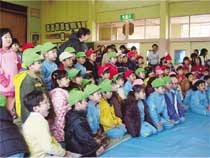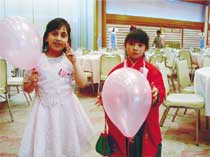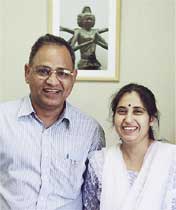Child Education in Japan
We have visited KEK, Tsukuba for one year assignment from August 2000 along with our two young daughters age 6 years and 3 years. This was our first visit to Japan and none of us knew even a little bit of Japanese language. Since our elder daughter was not 6 years old on April 2000, she could not be admitted to an elementary school (Sho-Gakko). We wanted to get a real Japanese exposure for our daughters and for ourselves during our stay in Japan.
We requested our Japanese host Prof. Yamazaki-san to help us in identifying and getting them admitted in to a kindergarten (Yochien). In the third week of August we visited one of the best Yochien of Tsukuba. Most of the schools open after the vacation in September.

It would have been impossible without the help of the Prof. Yamazaki-san to complete all the necessary admission formalities of Yochien, which were in Japanese. He also gave us the basics survival tips for the initial days. Yochien had three age groups for the children from 3 to 4 years, 4 to 5 years and 5 to 6 years. This Yochien has a bus facility to pick up the children from near KEK main gate. The children are accompanied & escorted by one of their teachers in bus to school. A couple of initial weeks were difficult for us and for our daughter because of our inability to read, speak and understand the Japanese language. As truly said that children do not need any language to become friends. Our daughter started to enjoy the Yochien by the end of the first month. We also started getting educated about Japanese life & customs through them. We also learned then how to write our names in Katakana. The student's name is to be written on all her articles. In Yochien they have a lot of activities including games, physical exercises, and out door activities like picnics and forming for the young children. Parents are called every month to witness the school activity and get a feed back from the school. A good amount of participation is expected from the parent side. It has also helped us in making friends with some of the other parents. From the Yochien, we used to get almost every other day a written notice, mostly information about their schedule activities. Reading and understanding of the notices was just impossible for us. We were ashamed to trouble our local host every now and then, but thanks to some of our friends like Onishi-san, Shibasaki-san and the most friendly person in KEK Prof. Ohska-san who made our life much easier. By the end of March the education in Yochien was completed and we witnessed a memorable and emotional send off party of the final year students of Yochien. Meantime we received a letter from the Tsukuba City office to contact Oho Sho-Gakko for the admissions of our elder daughter in class I in April. By this time our daughter was able to speak and understand Japanese language reasonably well and then she played, very proudly, a role of our interpreter in Japan. In elementary school one of the teachers could speak English therefore the admission formalities were not difficult. As usual we approached to dear Ohska-san to help us in completing all the paper work required for the admission. There is no bus facility in the elementary school and all the children are supposed to come on their own to school. There is no dress code in the elementary school except on the day of physical education class. We observed an affectionate relationship between teacher and her student.
 |
| Our daughter, Ananya with her Japanese class mate. |
The teacher is like a mother in Japanese Sho-Gakko. She loves and cares for every student and appreciates and motivates children to become a good person. We saw the development of living together spirit in the school. The Japanese school system must have played a very important role in shaping the society and the famous work culture of Japan. Our daughter was very happy to go to elementary school right from day one and enjoyed her education. We used to get notices in English from the school sometime and happy that school understands the problem of non-Japanese parents. It was a difficult moment for her and for all of us to bid Sayonara in July just before our departure to India. We must confess that it would have been incomplete during our stay of one year to learn about Japan, its custom and the Japanese people if we had not put our kids to the Japanese schools. It had given us an opportunity to experience life similar to Japanese parents.

The authors of this article:
Abha & Satish Satish Chandra Joshi, a scientist from Centre for Advanced Technology, Indore India visited KEK to work on JHF Project from August 2000 to July 2001. Satish was accompanied by his wife, Dr. Abha and two daughters, Ananya and Soumya age 6 years and 3 years. During the one year stay the family stayed in the on-site apartment of KEK.
